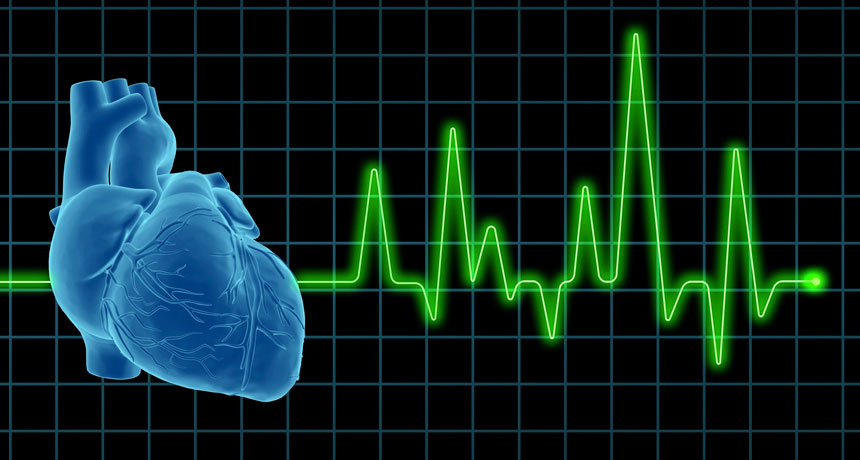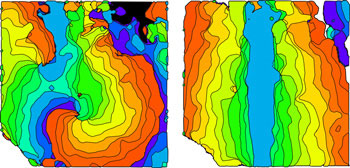Light can control waves in heart tissue
New technology can trigger action in heart muscle — and might one day even treat disease

Electrical waves in muscle let your heart beat steadily — unless something goes wrong. Experimental new work is using light to control unhealthy patterns in those waves.
angelhell/istockphoto
Share this:
- Share via email (Opens in new window) Email
- Click to share on Facebook (Opens in new window) Facebook
- Click to share on X (Opens in new window) X
- Click to share on Pinterest (Opens in new window) Pinterest
- Click to share on Reddit (Opens in new window) Reddit
- Share to Google Classroom (Opens in new window) Google Classroom
- Click to print (Opens in new window) Print
Researchers have found a new way to take charge of an out-of-control heart. All it takes is a light touch — literally touching the heart with a pulse of visible light.
Your heart beats tens of thousands of times each day. Its pace may speed up or slow down as your activities change. Yet its rate remains fairly regular, thanks to electrical signals that travel as waves from cell to cell through the heart. Those waves spread in somewhat the same way that a wave ripples through a baseball stadium as fans stand up and sit down in a coordinated fashion.
But watch out if something goes wrong with the heart’s waves of activity.
A wave sometimes spirals back on itself, for example. It’s almost looks “like a dog chasing its own tail,” explains Gil Bub. As a biophysicist at the University of Oxford in England, he studies the physics of life functions, particularly those of the heart. Such spiral waves that cross back on themselves can make the heart beat too quickly. And that can be deadly.
Medicines or electrical devices can reset — or sometimes even take over — someone’s heartbeat. However, such approaches basically jolt the whole heart. Now, however, there’s a new method to fine tune the control of waves in that muscle that makes up your heart.
“What we’ve done is figure out a way to use light to control waves in a way that hadn’t been done before,” explains Bub. To do that, his group at Oxford worked with biomedical engineer Emilia Entcheva and her colleagues at Stony Brook University in New York.
Together, the researchers used a fairly new technology called optogenetics. Opto– refers to light. Genetics deals with the biological instructions in our cells. The technology uses light to either turn on or shut down genetically programmed actions in cells.
Until now, most people working in this field focused on the brain and nervous system. Among them is Keith Bonin, a physicist at Wake Forest University in Winston-Salem, N.C. He has used optogenetics to study brain cells called neurons. Electrical signals travel through these nerve cells and cause the release of chemicals that send messages to neighboring neurons.
Muscle cells in the heart also produce electrical signals. However, these signals spread from cell to cell in a different way — as waves. Working with heart-muscle cells, Bonin says, “is an interesting new application of the tools of optogenetics.”
How the technique works

Those channels let in charged atoms, called ions. These ions, mostly of sodium plus some calcium, have a positive charge, so they’re also called cations (KAT-eye-uns). When enough of them flow in, an electric current begins to flow. If the current becomes strong enough, it triggers processes in the cell. Those processes lead to an electrical spike, called an action potential. The cell responds by contracting.
The action potential also sets off a wave of activity that spreads to other cells. Those cells in turn go through processes that lead to electrical activity and cause each cell to contract. The wave of activity is what allows the heart to contract in a coordinated way.
Using a computer-controlled projector, researchers shone blue light through a cable made of optical fibers onto a few heart cells. This started the flow of ions. And very precise changes in the aim and strength of the light could affect the electrical waves.
“We can control the direction” of the waves, says Bub. “We can control how fast they go.” The technique even can change the swirling of a spiral wave, also known as its chirality (Ky-RAAL-ih-tee). In heart tissue, a wave can swirl clockwise or counterclockwise, in a left-handed or right-handed direction. And if blue light shines on all the affected cells, it can shut down existing waves altogether.
In the future
Optogenetics “gives us a great way of doing experiments we couldn’t do before,” says Bub. “It gives us a really cool way of controlling how the waves propagate so we can understand the general patterns that are made.”
The technique also lets researchers compare waves moving through heart tissue against waves in other tissues or groups of cells. For example, similar waves can be seen in slime-mold colonies, the eye’s retina and the brain. Travelling waves also happen in physical systems (such as winds) and in some chemical reactions.
At some point in the next few decades, optogenetics might even lead to new ways to treat heart disease. Doctors generally do not treat disease by altering genes in people or changing how they work. Work along those lines is called gene therapy. It focuses mainly on diseases that are currently incurable.
However, gene therapy could become common in the future. If that happens, then perhaps doctors could make damaged parts of patients’ hearts sensitive to light. Afterward, doctors could use optogenetics to regulate a patient’s heartbeat.
Eventually, the approach might prove safer and less painful than other treatments, such as electrical shocks or surgery to implant pacemakers (which eventually wear out). But, Bub adds, that’s a long way off.
Bonin agrees that many questions need to be resolved. For one, can the new method control the muscles’ motion in the same way that the heart usually does? “Being able to reproduce actual mechanical motion that can mimic real tissue would be an important future step,” Bonin says.
Other issues include learning how to modify heart muscle cells in a living patient. To do that, biomedical engineers first would have to figure out how and when to deliver light to those cells in a precise way. There are lots of other medical, practical and ethical hurdles, too, notes Bub.
Meanwhile, the new technique can shed light on how the heart works. Bub’s team published its new findings in Nature Photonics on October 19.
Power Words
(for more about Power Words, click here)
action potential A brief change in the electrical potential on the surface of a cell, especially of a nerve or muscle cell. It happens when the cell is stimulated. This triggers the release of an electrical impulse.
atom The basic unit of a chemical element. Atoms are made up of a dense nucleus that contains positively charged protons and neutrally charged neutrons. The nucleus is orbited by a cloud of negatively charged electrons.
biomedical engineer An expert who uses science and math to find solutions to problems in biology and medicine; for example, they might create medical devices such as artificial knees.
biophysicist A scientist who studies the nature and properties of matter and energy as they relate to living things.
calcium A chemical element which is common in minerals of the Earth’s crust, and is also found in bone mineral and teeth.
cation An atom or molecule with a positive charge, due to the loss of one or more electrons.
cell The smallest structural and functional unit of an organism. Typically too small to see with the naked eye, it consists of watery fluid surrounded by a membrane or wall. Animals are made of anywhere from thousands to trillions of cells, depending on their size.
chirality The quality of a pattern or form that can exist as a mirror image of itself, such as a right hand or a left hand. Chirality is sometimes referred to as “handedness.” For a spiral, chirality generally describes whether the swirl travels in a clockwise or counterclockwise direction.
ethics (adj. ethical) A code of conduct for how people interact with others and their environment. To be ethical, people should treat others fairly, avoid cheating or dishonesty in any form and avoid taking or using more than their fair share of resources (which means, to avoid greed). Ethical behavior also would not put others at risk without alerting people to the dangers beforehand and having them choose to accept the potential risks.
fiber optics The use of thin, flexible fibers of glass (known as optical fibers) or other transparent solids to transmit light signals, chiefly for telecommunications.
gene (adj. genetic) A segment of DNA that codes, or holds instructions, for producing a protein. Offspring inherit genes from their parents. Genes influence how an organism looks and behaves
gene therapy The treatment of disease by changing an organism’s genes or how they work. That could be done by changing the genetic code, adding additional genes or changing the expression of a gene in the code. At this time, any work on gene therapy is generally limited to experimental work related to diseases that have no other cures.
genetic engineering (or genetic modification) The direct manipulation of an organism’s genome. In this process, genes can be removed, disabled so that they no longer function, or added after being taken from other organisms. Genetic engineering can be used to create organisms that produce medicines, or crops that grow better under challenging conditions such as dry weather, hot temperatures or salty soils.
ion An atom or molecule with an electric charge due to the loss or gain of one or more electrons.
mechanical Having to do with the devices that move, including tools, engines and other machines (even, potentially, living machines).
muscle A type of tissue used to produce movement by contracting its cells, known as muscle fibers. Muscle is rich in protein, which is why predatory species seek prey containing lots of this tissue.
optogenetics A technique that uses light to better understand genes and cells in the nervous system, especially the brain. Recent research is using the technology to study other types of cells and tissues too.
propagate To spread or proliferate, as a wave.
retina A layer at the back of the eyeball containing cells that are sensitive to light and that trigger nerve impulses that travel along the optic nerve to the brain, where a visual image is formed.
slime mold A simple organism that consists of a single cell of creeping, jellylike protoplasm containing nuclei. It is not a mold, despite its name; it isn’t even closely related to fungi.
sodium A soft, silvery metallic element that will interact explosively when added to water. It is also a basic building block of table salt (a molecule of which consists of one atom of sodium and two atoms of chlorine: H2O).
tissue Any of the distinct types of material, comprised of cells, which make up animals, plants or fungi. Cells within a tissue work as a unit to perform a particular function in living organisms. Different organs of the human body, for instance, often are made from many different types of tissues. And brain tissue will be very different from bone or heart tissue.
wave A disturbance or variation that travels through space and matter in a regular, oscillating fashion.







